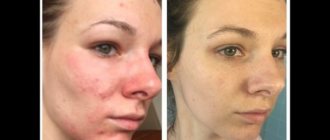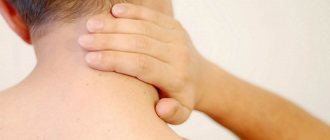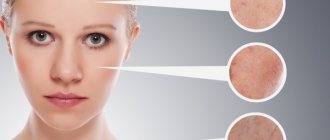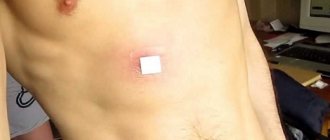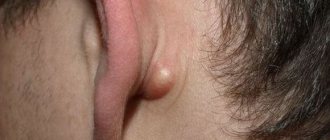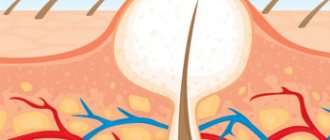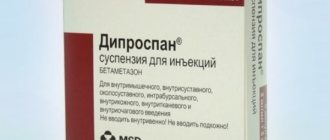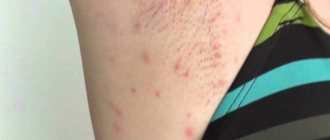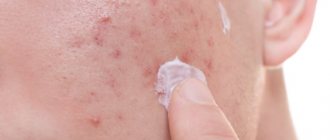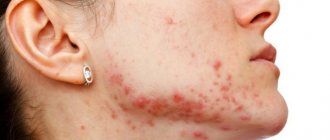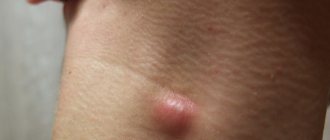Types of skin irregularities and causes of their appearance
You need to know the enemy by sight. Therefore, first learn about various skin diseases that are accompanied by structural disturbances, deformation of the surface layer of the dermis and the formation of bumpy facial skin.
- Enlarged pores - ducts of sweat and sebaceous glands emerge through small points on the skin (pores). When there is excess production, the pores stretch, become inflamed at the edges, and rolls of dense tissue form.
- Acne and its consequences - It has been proven that the main cause of acne is hormonal imbalance. The body has an increased sensitivity to the sex hormone testosterone and responds by increasing the production of fat by the sebaceous glands. As a result, the ducts of the glands become clogged, and a dense, enlarging formation appears in this place. If an infection gets into the ducts, rapid infection occurs and an inflammatory process develops with ulcers and dense bumps on the surface. Demodicosis leads to such consequences. This disease is caused by tiny mites that penetrate enlarged pores or sebaceous glands.
- Scars and cicatrices - occur as a result of cuts, injuries, burns of the face, and prolonged inflammatory processes. In places of scars, the skin loses its collagen, elastic tissues are replaced by dense fibrous inserts. They deform the surface and disrupt all functions of the epidermis.
- Hyperpigmentation - ultraviolet rays in high doses cause sunburn of tissue. As a result, not only rough spots appear, but also the production of your own hyaluronic acid, and, consequently, collagen synthesis stops. All skin restoration processes are disrupted.
- Inflammation - any inflammatory processes require gentle treatment. “It will go away on its own” means that the process may result in the appearance of scars and unwanted deformities.
These are the main reasons. You can calculate them yourself, but you still cannot do without additional diagnostics, so do not neglect the capabilities of modern laboratories in cosmetology.
Many cosmetic and health problems are reflected on the face and this cannot but upset us. Generally speaking, the causes of facial lumpiness are:
- sometimes the face becomes uneven in the place where the ducts of the sebaceous and sweat glands emerge through the enlarged pores (with an excess of skin secretion, the pores become even wider, their inflamed edges form compactions on the surface of the dermis);
- It happens that alignment after acne is the main reason for the formation of the “orange peel” problem (the consequences of acne, when the ducts of the skin glands become clogged, seals grow and lumpiness can spread across the face);
- the dermis loses its elasticity, and fibrous inserts deform its surface in places of scars, cuts, burns, long-term inflammatory processes, hence the problem of tuberosity;
- Besides everything else, uneven skin is the result of hyperpigmentation (the merciless sun scorches the dermis and rough patches grow on the tissue).
Causes
Provoking factors for the formation of this rash:
- hormonal imbalance;
- metabolic failure;
- skin diseases of a chronic and hereditary nature;
- unbalanced diet, excessive consumption of high-calorie foods;
- stressful situations and bad habits;
- allergies, use of hormonal medications;
- Mechanical trauma to the skin with infection provokes a rash and the appearance of a painful subcutaneous rash.
Having found out the nature of acne, its location, and general condition, it is possible to determine which risk group a particular person belongs to.
A few simple rules for women to note
For women who are unlucky enough to have bumpy facial skin, it is very important to be aware that the skin becomes this way for a reason, and the main reasons are hidden in contaminated pores. There are women who do not pay much attention to this and are at great risk. After all, this type of skin requires continuous and very careful care and mandatory treatment.
First of all, it should be noted that lumpy facial skin does not tolerate the use of soap. It is soap that causes more subcutaneous sebum to be secreted, resulting in unpleasant blackheads, acne, and subsequently inflammation. For bumpy skin, the ideal option would be to use special gels that subjugate the activity of the sebaceous glands and also perfectly moisturize it.
What it is
Large subcutaneous acne is a problem for people regardless of age, predisposition to inflammation and other factors.
The active functioning of the sebaceous glands leads to intensive separation of subcutaneous sebum; the ducts are considered a breeding ground for a variety of pathogenic microorganisms. Collectively, these circumstances contribute to stimulating the inflammatory process.
The rash forms in the lower layers of the skin. Deterioration of the immune system and hormonal imbalance lead to inflammation and the formation of a large subcutaneous pimple.
From the outside and to the touch, this rash looks like bumps, characterized by severe discomfort and itching. Subcutaneous neoplasms take a long time to mature and are able to not reveal themselves as a purulent core.
Causes of acne on the forehead in men
Pimples on the forehead in women can occur for the following reasons:
- stress, anxiety, nervous breakdowns;
- errors in nutrition, which leads to dysfunction of the gastrointestinal tract;
- smoking and drinking alcoholic beverages;
- excessive use of cosmetics in the form of scrubs and peels at home;
- lack of vitamins in the body;
- hormonal changes, for example, before menstruation, during menopause, during pregnancy;
- frequent touching of the forehead with dirty hands;
- weather and climate change, increased humidity;
- taking certain medications, such as antibiotics.
Men may suffer from forehead acne due to the following:
- hereditary factor;
- stressful conditions;
- hormonal imbalance during puberty, for example;
- dry skin on the face;
- dandruff and oily scalp;
- closed pores and oily skin type.
Subcutaneous acne on the face
Subcutaneous acne appears with equal frequency both in adolescence due to hormonal changes in the body and in adults.
The disease is an inflammation of the ducts of the sebaceous glands located deep in the skin. As a result, a large volume of pus accumulates in the tissues, which leads to the formation of white, yellowish, red tubercles and nodules on the surface of the skin.
The area of localization of internal acne depends on the area most susceptible to inflammatory processes. Most often, an unpleasant phenomenon is observed on the back, on the arms in the shoulder area, on the neck, chest, and face.
A white subcutaneous pimple is a subcutaneous pustule (a cavity filled with pus) formed under the epidermis layer.
An internal red pimple is an inflamed area of dermal tissue that, as a result of swelling, increases in size and rises above the surface of the skin.
Reasons for appearance
Blockage and inflammation of the ducts of the sebaceous glands on the face and body of a person, leading to the appearance of subcutaneous acne, can be caused by a number of reasons. The most common ones are:
· Hormonal disorders in the body (puberty, pregnancy, lack of estradiol during menopause, etc.). Diseases caused by disruptions in hormone production. Neuroendocrine diseases.
· Disturbances in the functioning of immune cells and, as a result, active reproduction of pathogenic microflora on the skin.
· Skin diseases associated with the production and disruption of the outflow of sebum (for example, seborrhea).
· Mechanical damage to the sebaceous glands.
· Diseases of the gastrointestinal tract, liver.
· Failure to comply with facial and body hygiene measures, incorrectly selected cosmetics.
· Unbalanced diet with excess sweet, salty, fatty foods.
· Increased sweating, sometimes due to wearing synthetic clothing.
· Hereditary predisposition.
· If the disease is difficult to treat, especially in combination with other types of acne, the cause may be helminthic infestation.
· The subcutaneous mite (Demodex), which parasitizes hair follicles on the face and body, can cause acne in people whose skin is prone to oily skin.
· Subcutaneous pimples on the neck can appear due to regular friction or pressure from tight collars.
· Inflammatory phenomena on the chin and cheek in men often form due to non-compliance with hygiene measures after shaving.
Symptoms and signs of internal pimple
Under the influence of provoking factors, the ducts of the sebaceous glands become inflamed. Due to swelling of the dermal tissues located around the sebaceous gland, the outflow of sebum is disrupted. Excess of it, along with dead cells, begins to accumulate in the deep layers of the skin. As a result, a reddish or pink lump forms on the surface of the face or body and is hard to the touch.
The size of a red subcutaneous pimple varies from 1-2 mm. up to a centimeter or more.
Due to the further development of the inflammatory process, as well as infection of the affected area by microorganisms that are constantly present on human skin, a subcutaneous purulent pustule is formed. Externally, this phenomenon is a growth that rises above the skin, white or yellowish in color, without an opening. Since the pus is completely hidden by a layer of skin, removing such a pimple is quite difficult.
In some cases, the accumulation of a large volume of pus leads to the rapid growth of acne. When the process is advanced, large nodes give the skin a characteristic bumpiness and an unhealthy reddish tint.
Red pimples may not form purulent pustules for a long time, causing itching, discomfort, and pain when touched. Small subcutaneous pimples are often located on the forehead and nose of a person, leading to general inflammation in these areas. Formations on the lips appear immediately under the red border and are most often small in size due to inflammation of the small sebaceous glands.
If the disease is caused by a subcutaneous mite, the pimples may be multiple, bright red in color and located under a thin layer of skin. Symptoms are complemented by itching and flaking of the skin.
Effects on the skin
The main problem that threatens the appearance of subcutaneous acne is a decrease in the attractiveness of the skin of the face or body.
Self-squeezing of formations can lead to damage to new areas of the skin, and in some cases, to generalization of the process, as well as blood poisoning.
Since acne is located deep in the skin, improper treatment and removal often causes scars that are difficult to treat.
Treatment of subcutaneous acne
The choice of treatment methods is made by a dermatologist.
For mild skin lesions, it is recommended to visit a cosmetologist to carry out a set of measures to combat subcutaneous acne:
· Professional masks against acne formation.
· Leather cleaning (vacuum, mechanical, using galvanization).
· Microdermabrasion – skin peeling using hard microcrystals to remove the top dead layer of cells. Accelerates blood circulation and improves skin condition.
· Acid peeling. It works in the same way as the previous method, but the active substance is able to penetrate deeper into the cells of the epidermis.
· Laser resurfacing – removal of the surface layer of cells using a medical laser beam.
· Disincrustation (opening a pimple and removing its contents).
· Mesotherapy – subcutaneous administration of drugs that help relieve inflammation and restore the skin.
In severe cases of skin lesions, systemic and local therapy is prescribed:
· Antibacterial treatment (tetracyclines, macrolides).
· For forms of the disease that are difficult to treat, use systemic retinoids (isotretinoin).
· Hormonal therapy is used in women with estrogen deficiency (estradiol preparations).
· Vitamins A, E, C, group B, brewer's yeast, omega-3,6 acids.
· Zinc preparations (zincteral, zinc sulfate).
· Autohemotherapy (intramuscular injection of one's own venous blood).
· Local antibacterial therapy - triclosan, benzoyl peroxide, erythromycin ointment, clindamycin, tetracycline ointment, levomekol, syntomycin ointment.
· Topical retinoids (clenzit, isotrexin, differin, effezel).
· Rubbing problem areas with salicylic acid 3%, rubbing in ichthyol ointment, sulfur preparations, tar.
Physiotherapeutic and hardware methods for treating subcutaneous acne:
· Ultraviolet irradiation (promotes the treatment of acne, fights pathogenic microflora).
· Phototherapy (used to accelerate tissue regeneration).
· Magnetic therapy (has a resolving effect).
· Ozone therapy (relieves swelling, inflammation and destroys pathogens with oxygen).
· Elos-therapy (impact on inflammation with blue light pulses).
Self-removal of internal acne
It must be remembered that it is strictly forbidden to remove red internal pimples on your own .
As a result of the mechanical impact on the formation, swelling and inflammation can increase many times over.
Since these pimples do not have purulent contents, there is no reason to try to squeeze them out. At home, you can only remove small white pimples located on the body, while following all the recommendations given. Failure to comply with measures for antiseptic treatment of skin and instruments threatens the development of furunculosis!
Before the procedure, you must thoroughly disinfect your hands and face with an antiseptic solution (for example, chlorhexidine). It is even better to perform all actions with sterile disposable gloves. A thin disposable medical needle makes a puncture in the area of the pimple that protrudes most above the surface of the skin. Next, using gentle finger pressure, you need to carefully squeeze out the purulent contents of the pimple mixed with blood and lymph, trying to completely clean it of pus. Then wipe the problem area of the skin with a cotton swab or bandage swab moistened with vodka or alcohol. It is recommended to perform the procedure before bedtime.
Treatment with folk remedies
For a small area of skin damage from internal acne, as well as in addition to the treatment methods recommended by a specialist, you can use traditional medicine:
· Knowing how to remove subcutaneous acne from the face and body using home salt cleansing, you can significantly save on the services of a cosmetologist. To carry out the procedure, you will need a mixture of table salt and soda in a 1:1 ratio. Moisten a cotton pad with camphor alcohol, dip it in the salt mixture, and then thoroughly wipe the face and problem areas of the body; Each zone must be treated with a new disc. Finally, wash your face and apply any cream for oily skin.
· It is recommended to wash your face daily with an infusion of St. John's wort or calendula flowers, prepared at the rate of 1 spoon of raw material per 200 ml. boiling water
· Rubbing the skin with a pharmaceutical alcohol tincture of calendula is an effective method against subcutaneous acne.
· 3 times a week it is recommended to make white clay masks on problem areas. To prepare, mix 10 grams. talc and clay, 60 ml. milk. Another recipe: 3 tablespoons of clay, 20 ml. calendula tincture, 15 ml. lemon juice. The mask must be left on the skin for at least 20 minutes.
· A decoction of birch buds will help cope with red internal pimples. 10 gr. kidneys pour 250 ml. water, let it boil, then leave for 3 hours. Wash or wipe your face and body every day, and also apply moistened gauze swabs in the form of lotions.
· Brewed leaf green tea must be cooled, moistened with gauze generously and applied to the face or body for 30 minutes. This method helps relieve inflammation and pain from red pimples.
· You can get rid of subcutaneous acne using ground coffee. After steaming the skin, you need to thoroughly treat it with a mixture of 1 spoon of coffee and 20 ml. tea tree oil.
· Squeeze the juice from the lemon, dilute it with water in a 1:1 ratio. Use as a lotion for daily wiping of inflamed skin areas.
· Crush aspirin tablets (1 package), add water to a paste. You can treat your face and body with this mass, thoroughly rubbing it into the skin 1-2 times a week.
· Wash the aloe leaf, beat it a little, apply to the affected area of the skin for 30-40 minutes.
· It will be useful to take 50 ml. Nettle infusion 3 times a day. The product perfectly strengthens the immune system, relieves inflammation and swelling.
Prevention
If you are prone to acne or have oily skin, it is recommended to follow these recommendations to prevent the appearance of internal acne:
1. Dietary food with limitation of sweet, spicy foods. Inclusion of vegetables, fruits, dairy products, and fish in the diet.
2. Walking in the fresh air, doing aerobic sports.
3. Giving up bad habits.
4. Daily thorough skin care with the selection of cosmetics and hygiene products according to its type. It is not recommended to use decorative cosmetics that prevent the outflow of sweat and sebum.
5. Avoiding injury to the skin. If they are damaged, timely disinfection is required.
6. Preventive use of herbal infusions for washing and rubbing the skin, baths with sea salt.
7. Elimination of hypothermia.
8. Treatment of chronic diseases, prevention of infectious diseases.
Be beautiful and healthy!
© The materials were obtained on the Internet from open sources, are presented for informational purposes only, and are the property of their legal copyright holders.
How to deal with uneven facial skin: home remedies
First, you need to adhere to a strict diet: foods that promote sebum formation are excluded from food. Fatty, sweet and flour dishes, all kinds of pickles and marinades, hot seasonings, and alcoholic drinks are limited. It is allowed to eat dairy products and eat a lot of vegetables and fruits.
Vitamins A (contain red and orange vegetables and fruits) and E (all nuts except peanuts, the best are almonds) are shown. Masks and lotions from folk remedies are convenient for home use for lumpy skin. They are aimed at softening the bumps, moisturizing and nourishing the epidermis, and normalizing the functioning of the sebaceous glands. Here are the most popular and tested recipes.
- Aloe leaf lotion - first leave the leaves in the refrigerator for two hours, then pour a tablespoon of crushed leaves into a glass of hot water and leave for two hours. You need to wipe your face several times a day every day.
- A tincture of white lily petals is prepared as follows: place a full jar of petals tightly, pour in vodka, and put in a dark place for two weeks. Use the lotion daily at night to treat your face.
- To eliminate demodicosis, it is recommended to use an aqueous infusion of juniper berries or wormwood herb (infuse one tablespoon per glass of boiling water for four hours). After degreasing the skin with any alcohol-containing product, apply lotions to the bumpy areas.
- Laser peeling or facial resurfacing uses the property of a laser beam to stimulate the skin's production of its own collagen. This allows you to remove shallow wrinkles and scars. The procedure lasts twenty minutes and is painless. After finishing, the skin turns red. Recovery takes seven to ten days. The method can only be performed in a trusted clinic by an experienced doctor. To eliminate deep bumps, the penetration of the rays must be sufficient. Doctors know the capabilities of their device and will recommend the mode and frequency of procedures.
- Ultrasonic cleaning - with the help of hardware ultrasound, impaired functions of the skin are restored (inflammation is relieved, allergic reactions are eliminated, collagen and elastin synthesis is enhanced). Cleaning removes dead skin cells of the epidermis, smoothes it, and promotes the penetration of active ingredients from masks and creams. It is recommended as a cleansing procedure for relatively unpronounced skin unevenness.
- The method of disincrustation using galvanic current allows for cleansing at a deeper level and gets rid of old seals. First, an alkaline solution is applied and the treatment is first carried out with a negative current; after seven to ten minutes the charge changes to positive. This relaxes the ducts of the sebaceous glands, allows the accumulated secretions to escape, and relieves inflammation.
- Mesotherapy - the active ingredient is one of the preparations based on hyaluronic acid. It is administered by injection with a thin needle into the tissue according to the scheme. In this case, under visual control, the missing agent responsible for tissue reconstruction, hydration, and elasticity is returned to the skin. There is a fight against inflammatory changes. A course of treatment requires six to eight procedures. It needs to be repeated twice a year.
- Chemical peeling. Deep resurfacing is a procedure at the surgical level, performed in a hospital setting once in a lifetime. Requires a fairly long recovery period. In cosmetic hospitals, superficial chemical peeling using acids (lactic, mandelic, glycolic, salicylic) is widely used. Allows you to remove unnecessary dead cells. Rejuvenate tissues and straighten tubercles, activating its own regeneration processes. Before the procedure, preparation is necessary using products with weak fruit acids. This improves the effect of chemical peeling. It is recommended in the autumn, as thin skin becomes extremely susceptible to sunlight.
How to deal with uneven skin and achieve significant results? Take your time. This will be a major mistake. If you decide to undergo serious treatment, use the advice of professionals. You can’t apply everything at once or overload the skin: this will only weaken its protective properties. Start with home care and be patient; with the right approach, improvement will definitely come.
How to get rid of subcutaneous tubercles?
Treatment methods depend on the reason for the appearance of pimples on the skin and what they are. Often, with such a problem, it is recommended to check the condition of the gallbladder, thyroid gland, stomach and intestines. Most likely, in order to identify the cause, you will need to take a lot of tests: blood for hormones, cholesterol levels and other indicators, urine, feces, in some cases (for example, if you suspect demodicosis) - do a skin scraping analysis.
The reasons can be different: from staphylococcus infection to banal improper skin care, so it is better not to self-medicate. If you act on the wrong cause, there will be no result. As treatment, the doctor may prescribe the use of hormonal drugs, antibiotics, sedatives, the use of local therapy products, for example, Baziron, Skinoren, Zerkalina, Zenerit, Differin, etc. In addition, a dermatologist may suggest that you remove the subcutaneous tubercles using one of the following methods:
- electrocoagulation;
- laser treatment;
- ozone therapy;
- professional cosmetological facial cleansing;
- superficial skin peeling;
- mechanical removal with special medical instruments.
The main rule of treatment is do not try to open the “subcutaneous tissue” yourself. This will only make the problem worse. The infection can spread to healthy skin, and an unsightly scar will remain in place of the squeezed out bumps. In addition, as a rule, the subcutaneous tubercles do not suppurate, and there is practically no content inside them, so there is, in fact, nothing to squeeze out there.
Photo: Before and after
See how to treat acne on the cheeks. About common acne Acne Vulgaris. Find out further.
Is it possible to remove large blackheads? The answer is here.
When problems with the skin are mild and insignificant, it is possible to get by with regular skin cleansing procedures and the use of natural cosmetics.
Caring for the dermis of the face and body should become a daily necessity. However, the appearance of large subcutaneous pimples on the skin requires an immediate visit to the doctor. He will carry out the necessary diagnostic measures and prescribe appropriate treatment.
Moisturize your skin
Apply coconut oil or anti-aging serum with aloe to the problem area, or a special cream for wrinkles on the forehead with retinol, retinoids, and peptides. Products with alpha hydroxy acids, vitamin C, idebenone, and growth factors are effective for moisturizing. There is no need to save money; choose pharmaceutical drugs with good reviews. These products are often sold with narrow tips for precise application of the product to problem areas. One application will take 2-3 drops.
- Vegetable stew with chicken
- Medical examination 2021 - schedule by year of birth
- What to cook from minced chicken
Lump on the forehead: signs of the disease
Minor head injuries most often result from play, sports, or falls in the home when the head (usually the forehead) hits a hard object or the floor.
After a fall and bruise of the forehead, a person may lose consciousness (rarely lasting more than a few seconds), and a hematoma may form on the forehead. As a rule, “stars” appear before the eyes and dizziness.
Headaches are also common, aggravated by movement and bending.
Sometimes a bump on the forehead is not the worst consequence of a head blow; the victim may not remember the events that occurred immediately after the injury (post-traumatic amnesia), remembering what preceded it. These symptoms usually last no more than a few hours. After an injury, it is advisable to consult a doctor, especially if unconsciousness lasted more than 5 seconds.
What to do if a bump appears on your forehead
After a head injury, a huge lump or bruise may appear on the forehead, which often hurts when pressed. You should not experiment with treatment, especially if the child hit his forehead; you should not try to quickly remove the bump! If swelling occurs, it is better to let it go away on its own.
How can a bump grow on the forehead under the skin? Under the site of impact, a mixture of intercellular fluid, skin tissue (fibers consisting of collagen protein) and blood coagulating blood proteins accumulates. The result is a soft or hard lump, an insoluble, gradually hardening compound that forms a bulge.
After a few days, the emerging tumor resolves without consequences. Sometimes the site of the impact does not hurt, but changes color. If a lump appears without blood, it is almost white. The growth containing red cells has an expressive color.
The cause is the red blood dye hemoglobin, which breaks down into green biliverdin (which then forms yellow bilirubin).
As first aid for a bump on the forehead from a blow, you can immediately apply an ice pack (or frozen vegetables) to the injured area and tighten the small circular muscles around the arterioles (the so-called precapillary sphincters). This almost immediately stops the blood flow to the damaged area, resulting in a small bump on the forehead, but only a slight bulge.
First aid:
- If the person is conscious, allow him to take the most comfortable position, avoid exposure to cold, treat the wound, monitor the condition of the victim, and resolve possible complications.
- If the victim is unconscious, first of all, provide basic vital functions.
- You should call an ambulance or consult a doctor if you experience symptoms of a concussion, injury in a newborn or infant, or the presence of post-traumatic amnesia.
Signs that you should sound the alarm if present
If an adult or child hits their forehead hard, symptoms of a concussion may occur that require evaluation:
- headache,
- visual disturbances,
- dizziness,
- nausea,
- loss of balance,
- confusion,
- tinnitus,
- impaired concentration,
- amnesia.
Concussion in children and adults is classified as a mild head injury, usually without consequences. However, it is important to pay attention to symptoms that may indicate a more serious injury, such as intracranial bleeding.
If an adult or child falls or hits their forehead, pay attention to the following warning signs:
- neck stiffness,
- motor and speech disorders,
- long term headache
- repeated vomiting
- worsening confusion
- convulsions,
- severe drowsiness,
- numbness of the limbs.
Treatment of a bump on the forehead
How to remove a bump on the forehead after a blow and help speed up the healing of bruises? Try these tips:
- If you have a bump or bruise on your forehead, immediately cool the area of the impact (at least 10 minutes).
- Raise your legs above heart level.
- Gently massage the bud to speed up its absorption through the lymphatic system. Start massaging no less than 2 days after the bump or bruise appears on the forehead.
- You can anoint the bump with a special ointment, gel, cream containing an anesthetic ingredient and substances that promote the absorption of bruises.
- After 2 days, on the contrary, you can quickly get rid of the bump on the forehead by supporting blood circulation with a warm towel.
- If a bruise does not go away in adults, it is advisable to expose it to sunlight, which promotes the distribution of hemoglobin metabolites, thereby accelerating the fading of the hematoma on the forehead. Children are recommended no more than 15 minutes in the sun!
Important! Remedies for bumps on the forehead can be applied to bruises on both adults and children.
Ointments and other drugs
The most popular medications to treat a bump on the forehead from a blow:
- Wobenzym. The ointment contains enzymes that counteract inflammation. They accelerate the absorption of swelling and bruising, and reduce the healing time after injury. Suitable for treating a bump on a child's forehead due to a blow.
- Heparoid. The product is intended for the treatment of tendon inflammation, post-traumatic swelling, bruising, and softening of protruding scars.
- Lyoton. The gel contains heparin, a substance that promotes blood clotting. Lyoton can cure inflammation of the superficial veins, chronic venous insufficiency, hematomas and edema, as well as post-traumatic damage to muscles, tendons, and ligaments.
- Ibalgin cream. The cream belongs to the group of non-steroidal anti-inflammatory and antirheumatic drugs. Suppresses pain, reduces swelling and inflammation in painful post-traumatic conditions, local manifestations of inflammatory and degenerative diseases, relieves bone pain, venous inflammation.
- Aescin. The ointment and gel act against swelling and inflammation, normalize the permeability of capillary walls, and remove bumps on the forehead.
- Repaired. When you smear the bumps with this gel, swelling decreases, inflammation and pain are suppressed.
- Hirudoid. This gel is the next option for removing a bump from your forehead. It suppresses swelling and inflammation.
- Arnica ointment. An effective assistant that quickly removes a tumor on the forehead.
- Comfrey ointment. This popular herbal ointment is used mainly by athletes who often fall or get hit.
Folk remedies
If your child has a lump on his forehead, try using the advice of traditional medicine. Before treating a lump with any of the following methods, make sure you don't have an allergy or talk to your doctor about the possible risks:
- To make the hematoma go away faster, wipe it with vinegar mixed with warm water.
- Apply chopped parsley leaves to the impact site, securing with a bandage.
- Pour boiling water over the wormwood, apply it to the bruise, and fix it. This will help reduce pain and speed up the healing of bruises.
- Make compresses from thyme infusion. Pour 30 g of leaves into ½ liter of water, cook for 5 minutes, leave for 10 minutes, strain. The compresses should be warm.
- Honey has a good effect on absorbing bruises. Apply it to the affected area and cover with a bandage.
- Pour boiling water over young chestnut leaves. Place warm leaves on a bruise or bump and secure with a dry scarf. Instead of chestnut, you can use rue leaves.
- Compresses or baths from mallow soften hard bumps and heal bruises. Boil 25 g of leaves and flowers for 15 minutes in ½ liter of water, pour the broth into the bath or use for compresses.
- Wipe bruises and bumps with chicory root juice. For children, you can dilute the juice with water or mix it with honey.
- To speed up the healing of the consequences of blows, you can use high mullein flowers: boil 60 g of flowers for 5 minutes in 1 liter of milk. Compresses heal hematomas and swelling.
If bruising occurs frequently and after a small blow, increase your intake of rutin, which is found in buckwheat, blueberries, black rowan, red cabbage, and blackberries. Increase your daily intake of vitamin C. The best sources of vitamin C: onions, green peppers, red currants, sea buckthorn, horseradish, sauerkraut.
How long does it take for a hematoma to disappear after an impact?
Blood penetrating into the subcutaneous layer is responsible for the typical red tint of a fresh hematoma. After 1 to 2 days, the bruise usually turns blue or purple because the accumulated blood loses oxygen.
After about 6 days, hemoglobin begins to break down into biliverdin, which causes the greenish color of the hematoma. By day 8–9, the bruise usually turns yellow or brownish.
This coloring is caused by bilirubin, a bile dye into which biliverdin is converted and is completely absorbed over the next few days. 2-3 weeks after the blow, the hematoma should disappear so that no trace remains of it.
The site of the hematoma tends to swell and a lump forms. This is due to damage to the lymphatic capillaries, whose task is to continuously remove excess fluid from the intercellular space and transport it into the bloodstream. When capillaries are damaged, fluid and blood proteins accumulate at the point of impact, creating swelling that is absorbed within a few days.
Source: https://kvd9spb.ru/golovnaya-bol/kak-lechit-shishki-na-lbu
Prevention methods
To make your skin delight you with its smoothness and even complexion, try to follow the following recommendations:
- If your skin is prone to uneven skin, pay special attention to the cleansing step. Use exfoliating gommages and scrubs. But on the contrary, you should avoid alcohol-containing lotions. They dry out the epidermis, causing the sebaceous glands to produce sebum in double volume. This only causes clogged pores.
- Review your diet. If you eat sweets and cakes every day, often have processed dinners and often drink alcoholic beverages, your skin is unlikely to look perfect. Include more greens, vegetables and fruits in your diet, and take a course of multivitamins.
- If possible, avoid bright makeup. Often, subcutaneous comedones are a reaction to the constant use of foundation. Also, the appearance of bumps can be caused by the use of cream eye shadow. Give preference to dry, crumbly options, and instead of foundation, apply mineral powder. It is much more suitable for problem skin.
Prevention
To prevent the disease, the necessary preventive measures should be taken:
- lead an active lifestyle (exercise outside and walks);
- review of nutrition (eliminate or reduce the consumption of sweets, fatty, smoked foods, give up alcoholic beverages and coffee);
- follow the rules of hygiene (cleanse the skin of the face every day to eliminate the accumulating layer of subcutaneous fat and exfoliated dermis);
- ozone therapy (helps destroy pathogenic microorganisms and eliminate the inflammatory process);
- use decorative cosmetics (the plant extracts inside them help heal large subcutaneous pimples).
Protect yourself from the sun
The forehead is constantly open, due to excessive exposure to ultraviolet radiation, its skin quickly dries and wrinkles. If you spend a lot of time in the sun without protection, the first wrinkles will appear by the age of 20. To avoid this, apply sunscreen before going outside. Additionally, a headdress such as a Panama hat, hat or cap will provide additional protection.
- How does the flu shot affect coronavirus disease?
- 25 ways to organize your kitchen space correctly
- How to calculate the day of ovulation
